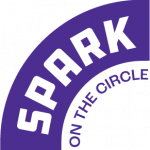By Rob Peoni, Spark writer in residence
If you lunch on Monument Circle on Thursdays or linger for a bit after the day’s final whistle blows, you may notice a couple of people who appear out of place. It’s not the people in green construction vests employing arts activities rather than repairing stoplights. It’s not even the Sasquatch circling a Wagon of Wonders. Well, they may be out of place too, but I’m talking about the woman and man perspiring in the early fall sun, outfitted in conservative, 19th century formal attire.
On the afternoon of my visit, the two sore thumbs were former Indiana First Lady Esther Ray Brown and former governor Oliver P. Morton (above). Or, rather, the ghosts of Eshther Ray Brown and former governor Oliver P. Morton. “They call us ghosts,” Brown says of the organizers behind the Spark Monument Circle programming. “Yes, we’re aware of our time, but we’re also aware of the time that you’re in. So, we don’t have to be so strictly in 1827 or so strictly in the 1860s. We can sort of go back and forth. We’re sort of omniscient in that way.”
Morton and Brown are two historical interpreters on loan from Indiana Historical Society. When he’s not wearing Morton’s signature three-piece suit, the man with the lush, white facial hair is Dan Shockley, I.H.S.’s director of museum theater. His partner-in-crime is Erin Cohenour, an interpreter at I.H.S. and local actress. “At the Historical Society, the actors you meet are in character the entire time that you’re with them,” Shockley says. “Here, we’re really ambassadors for Monument Circle and we’re in and out of character the whole time.”
This flexibility allows Governor Morton to employ his iPhone when the occasional out-of-towner stops to ask for directions. In fact, it’s more often non-natives who take the time to stop and interact with the historical figures. “If you’re from here, you’re probably not going to have a lot of time to stop and talk to us,” Cohenour says of the bustling lunch crowd. “But if you’re traveling and this is leisure for you, you’re going to have all the time in the world to talk with us.”
In addition to Brown and Morton, visitors to Monument Circle may also encounter the ghosts architect Alexander Ralston – responsible for the design of downtown Indy, or John Freeman – an African-American business man who owned a successful restaurant near Monument Circle in the mid-19th century. “We were passing by the Columbia Club and a woman stopped us to ask what we were doing and she was so impressed that we had a John Freeman character,” Cohenour says. “She did a lot of history with Underground Railroad and Indiana Landmarks, and she was so impressed that they had chosen that character. She just felt that he had a really great story to tell.”
Overall the reactions to the ghosts have proved more positive than petrified. While we conducted our interview beneath the shade of one of Big Car’s parklets, a random passer-by called out enthusiastically, “Hello, governor!” Shockley returned the acknowledgment with a wave and a smile.
“Certainly, Governor Morton would’ve been pleased with the monument,” Shockley says. “He is known as the soldier’s friend. Other than Deleware, Indiana sent the most number of soldiers to fight in the civil war. He was known for that, but also known for taking care of them once they came home. So, the fact that there are two statues dedicated to him within a two-block radius of the circle really speaks to the reverence people felt for him while he lived and very much after he passed away.”
For their part, Cohenour and Shockley have embraced the opportunity to get outside the confines of Indiana History Center to interject some history into the community at large.
“People may think this is a permanent fixture,” Shockley says of the Spark programming. “In six more weeks or so, this will be gone. I think once all of this is gone, people are going to realize what the Circle can be. It can be so much more than it is (without Spark). It’s beautiful as it is, but this helps bring people down to the Circle to see the monument, to stop, to read, and to learn something or just marvel at the beauty.”




